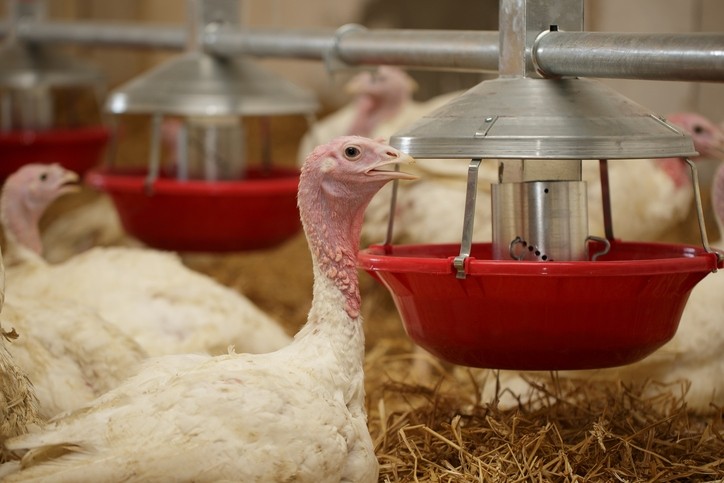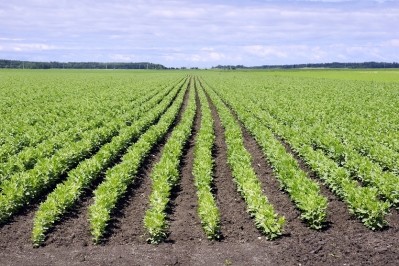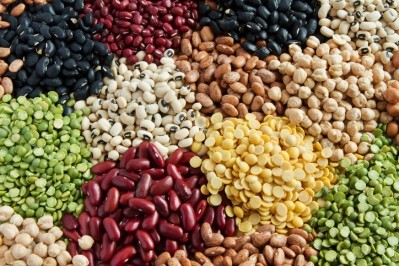Faba bean use may reduce SBM inclusion in turkey feeds

In an effort to understand the role of dietary tannins, and the potential to use faba bean (FB) seeds as a replacement for soybean meal (SBM) in turkey diets, an international team of researchers from Canada and Poland examined the use of high-tannin (HT) and low-tannin (LT) faba beans in the diets of farmed turkey.
The team published its work in the journal of Animal Feed Science and Technology.
“The aim of this study was to investigate how different dietary inclusion levels of HT or LT FB seeds (100, 200 and 300 g/kg) affect gastrointestinal tract (GIT) function and fermentation processes mediated by the activity of intestinal microbiota in turkeys,” the researchers said in the study.
The project came out of questions generated during a previous evaluation of faba beans as an alternative feed ingredient to soybean meal, said Bogdan Slominski, professor in the department of animal science with the University of Manitoba. It also helped generate a better understanding of if tannins can be used in turkey diets.
“Low-tannin faba bean seeds would appear to be beneficial for gut health by increasing butyrate production and decreasing pH of digesta,” he told FeedNavigator.
However, the feeding trials also generated a few surprises, including that there was a lack of differences in growth performance between birds, he said.
“This could be due to the fact that, due to plant selection in the last decades, the current ‘color-flowering’ (high-tannin) varieties of faba bean are not as ‘high’ in tannins as their predecessors, and the birds now can tolerate such moderate levels of tannins,” he said.
Overall, the research team found that turkeys on the low-tannin diets saw decreased jejunal crypt depth, smaller total counts for bacteria, increased ileal short-chain fatty acid (SCFA) concentrations and improved some parameters of intestinal functioning.
However, it was concluded that both low-tannin and high-tannin faba beans could be added at up to 300g/kg as a replacement for soybean meal (SBM) in turkey diets, the researchers said.
Why evaluate low- and high-tannin faba beans?
Evaluating the use of faba beans in turkey diets was a way to evaluate a locally grown and available feed ingredient, rather than relying on an imported protein meal, said Slominski.
“In Europe, the focus is on the utilization of local and non-GMO feed ingredients rather than imported SBM,” he said.
However, one element that has been reducing the feed value of seeds produced by color-flower faba beans has been the high tannin content, the researchers said. Previous experiments have demonstrated the negative influence tannins have on feed intake, protein digestibility and energy utilization.
Removing tannin-rich hulls can generate HT and LT faba bean seeds with similar nutritional values, but this practice is not often used, they said. Instead, there has been more interest on selective breeding of white-flowered varieties to improve yield and disease resistance.
Previously, LT FB seeds have been used in swine diets and feed for broiler chickens, they said. But chickens were only able to manage a moderate amount, about 150-200g/kg of the ingredient in feed.
It was surprising to find that both LT and HT FB seeds could be added to finisher diets for turkeys at levels up to 300g/kg, they said. The FB seeds were able to act as a substitute for SBM while maintaining performance, carcass traits and breast meat quality.
There has been limited evaluation of tannins in turkey diets, the researchers said. However, the birds do require a longer raising period and more feed than broiler chickens.
The current feeding study is focused on the small and large intestine of turkeys when tannins are present in the feed, they said. The work is part of a larger, multi-aspect experiment involving four research teams.
Feeding low- and high-tannin beans
In the feeding trial, 1,470 turkeys were given one of seven diets for a period of six-weeks starting when birds were 13 weeks old, the researchers said. The wheat-based control feed (FB0) used SBM as the only protein component.
The six experimental diets included either HT or LT FB at one of three inclusion levels – 100, 200 or 300 g/kg – to replace an amount of soybean meal, they said. The diets were iso-nitrogenous, iso-energetic and pelleted.
After six weeks sample birds on each diet were harvested and portions of the digestive tract and its contents were collected, weighed and analyzed, they said. The pH of the caecal digesta was measured, enzymatic activity of gut microbiota, microbial composition of caecal digesta, caecal bacterial enzyme activity and SCFA levels were established.
FB samples also were analyzed for elements including dry matter, crude protein, crude fat, neutral detergent fiber (NDF), acid detergent fiber (ADF) and trypsin inhibitor activity (TIA), they said.
Results
Both types of FB seeds had similar protein levels, although the LT seeds had slightly less starch and more NDF and oligosaccharides, the researchers said. Trypsin inhibitor levels were similar in both varieties but tannin levels and total polyphenols were higher in the HT seeds.
For the turkey, there were no significant influences on the histological parameters of the duodenum or caecum, they said. Mucosal thickness, villus height, crypt depth and the ratio of villus height to crypt depth were similar among the FB diets.
However, when compared to the control, the crypt depth values in the jejunum were lower for birds getting diets with LT FB, they said. No crypt depth difference was seen in the caecum.
Overall, both types of FB were able to be added to turkey diets with no adverse influence on GIT function, mucosal parameters or fermentation processes, the researchers said.
In the caecal digesta, total bacterial counts were lower for birds on LT diets than HT feeds, they said. When compared to the control, birds getting HT diets had increased amounts of Eubacteriaceae-family bacteria, while birds on the LT diets had reduced amounts.
Birds getting LT diets saw a drop in total activity of bacterial enzymes for some types of enzymes when compared to those on HT diets, they said. There also was a drop in β-glucuronidase activity for birds getting either LT or HT diets compared to the control.
“Tannins inhibit activity of microbiota which may have some beneficial effects in the upper gut where microbiota competes for nutrients (amino acids) with the host,” said Slominski. “In the lower gut, however, the decreased activity of beneficial bacteria would result in the lower production of SCFA and energy utilization.”
Compared to the control, birds getting any of the trial diets had an increase in SCFA levels in the small intestinal digesta, said the researchers. Birds on the LT diet had higher SCFA levels than those on the HT feeds.
However, the weight of the small intestine was heavier for birds on the control diet and HT diets, than for birds getting the LT feeds, they said. There also were mixed responses from SCFA production in caecal digesta.
Birds getting the LT feeds had higher levels of acetate and butyrate than those on the HT or control diets, they said. LT diets produced higher SCFA concentrations in caecal digesta than the control, while birds on the HT diet saw total concentrations drop.
Wider feed use implications and looking forward
Along with turkey producers, the results may have implications for those raising other poultry breeds and an interest in using a feed ingredient that has a level of tannins, Slominski said.
“The results could be useful for the production of slower-growing birds, more so than the fast-growing broilers,” he added.
Additionally, the group is continuing to explore alternative feed ingredients as a way to replace the reliance on soybean meal, he said. “The next study will focus on the full replacement of SBM by a combination of local protein supplements such as faba bean, lupin, peas or canola meal,” he added.
Source: Animal Feed Science and Technology
Title: Effects of dietary inclusion of high- and low-tannin faba bean (Vicia faba L.) seeds on microbiota, histology and fermentation processes of the gastrointestinal tract in finisher turkeys
Authors: Z. Zdunczyk, D. Mikulski, J. Jankowski, B.Przybylska-Gornowiczc, E. Sosnowska, J. Juskiewicz, R. Amarowicz, B. Slominski
DOI: doi.org/10.1016/j.anifeedsci.2018.04.006













